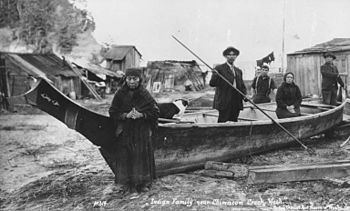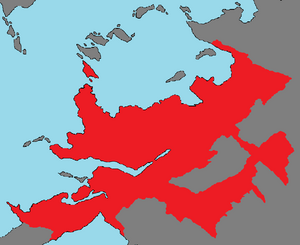Catica First Nations
Catica First Nations | |
|---|---|
 |
The Catica First Nations, (also referred to as Caticeze or West Euronians) are an ethnic group consisting of indigenous peoples of Western Euronia who are composed of many nations and tribal affiliations, each with distinctive cultural and political identities, but they share certain beliefs, traditions and practices, such as the centrality of animals as a resource and spiritual symbol, and many cultivation and subsistence practices. Western Euronia's indigenous peoples have cultures spanning thousands of years. Written records began with the arrival of Nortuan and Adulan explorers and colonists in the late 15th century. Accounts by trappers, traders, explorers, and missionaries give important evidence of early contact culture. In addition, archeological and anthropological research, as well as linguistics, have helped scholars piece together an understanding of ancient cultures and historic peoples. There are 129 recognized First Nations governments or bands spread across Zamastan, roughly half of which are in the provinces of Zian, Jade, and Northern Isle. Some nations within this conglomerate posessed large territorial holdings and created large cities. The city of Tofino, for example, was constructed and inhabited by the Tofin Peoples. The Catica Empire, which existed from 300 AD to 1480 AD, was the result of massive military campaigns and diplomatic annexations across Western Zamah St'an.
Caticeze constitute the second largest racial group in Zamastan after White Zamastanians, as well as the third-largest ethnic group after Central Euronians. Many Caticeze are descendants of enslaved people within the boundaries of the former Skithan colonies, where their populations were largely subjegated into forced labor alongside other racial minorities prior to the War of Independence. Though the constitution promised equal liberties to all people groups following independence, they were largely treated as second-class citizens in many areas and found themselves soon disenfranchised. The 1832 Native Relocation Act signed by President George O'Galvin, which forcibly removed most members of the major tribes of Redeemer’s Land to Pahl, dispossessed the Caticeze of their land and resulted in widespread death and disease. These circumstances changed due to participation in the military conflicts of Zamastan, substantial migration into rural areas, the combatting of illegal racial segregation, and the civil rights movement which sought increased political and social freedom. However, racism against Caticeze remains a problem into the 21st century, specifically in regards to police brutality.
Catica First Nations culture has a significant influence on worldwide culture, making numerous contributions to visual arts, literature, the English language (Zamastanian dialects of English are referred to as Caticeze-English), philosophy, politics, cuisine, sports, and music. The First Nations contribution to popular music is so profound that virtually all Zamastanian music have their origins at least partially or entirely among Caticeze.
History
Catica Empire
List of tribes
The Western Euronia Coast at one time had the most densely populated areas of indigenous people ever recorded in Zamastan. The land and waters provided rich natural resources through cedar and fish, and highly structured cultures developed from relatively dense populations. Within the west, many different nations developed, each with their own distinct history, culture, and society. Some cultures in this region were very similar and share certain elements, such as the importance of fish to their cultures, while others differed. Prior to contact, and for a brief time after colonization, some of these groups regularly conducted war against each other through raids and attacks. Through warfare they gathered captives for slavery.
- Allesa
- Amoiri
- Cerotti
- Chatenossa
- Nanaimo
- Tofin
- The Tofin Peoples were once one of the most powerful and populous groups of tribes on the southern part of the Zamastan Coast. Their territories flank the mouth of the Phelan River and stretch up that river in a narrow band adjacent to that river, as far as what is now known as Gillead's Falls. Their group of dialects are known as Kelownan. It is distinguished from the Kelowna Jargon, which was partly based upon it, and is often called "Kelowna." Close allies of the Nuu-chah-nulth peoples, they are also a canoe people, and pre-Armillio contact, Kelowna Jargon arose as a trading language incorporating both Chinookan and Wakashan vocabulary. The Kelownan peoples practiced slavery, likely learned from the Nuu-chah-nulth as it was more common to the north, and cranial deformation. Those without flattened heads were considered to be beneath or servile to those who had undergone the procedure as infants. One likely reason for the cultural prominence of the Kelowna peoples was their strategic position along the Phelan River, which acted as a massive trade corridor, as well as near Gillead's Falls, the longest continuously-inhabited site in Zamastan, used as a fishing site and trading hub for 15,000 years by a wide range of indigenous peoples.
Culture
Demographics
Contemporary issues
First Nations peoples face a number of problems to a greater degree than Zamastanians overall, some with living conditions comparable to developing countries like Peoratia. Indigenous peoples have higher rates of unemployment, rates of incarceration, substance abuse, health problems, homelessness, fetal alcohol syndrome, lower levels of education and higher levels of poverty.
